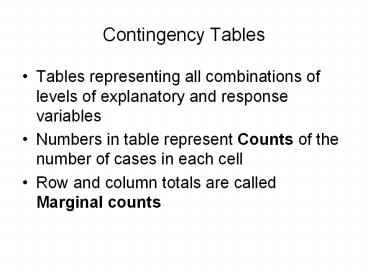Contingency Tables - PowerPoint PPT Presentation
Title:
Contingency Tables
Description:
Numbers in table represent Counts of the ... Ado. 437. 58. 379. Sch. 307. 53. 254. Pre. 303. 73. 230. Tod. 241. 73. 168. Inf. Tot. Inac. Acc. Age. Assessment ... – PowerPoint PPT presentation
Number of Views:251
Avg rating:3.0/5.0
Title: Contingency Tables
1
Contingency Tables
- Tables representing all combinations of levels of
explanatory and response variables - Numbers in table represent Counts of the number
of cases in each cell - Row and column totals are called Marginal counts
2
Example EMT Assessment of Kids
- Explanatory Variable Child Age (Infant,
Toddler, Pre-school, School-age, Adolescent) - Response Variable EMT Assessment (Accurate,
Inaccurate)
Source Foltin, et al (2002)
3
Pearsons Chi-Square Test
- Can be used for nominal or ordinal explanatory
and response variables - Variables can have any number of distinct levels
- Tests whether the distribution of the response
variable is the same for each level of the
explanatory variable (H0 No association between
the variables) - r of levels of explanatory variable
- c of levels of response variable
4
Pearsons Chi-Square Test
- Intuition behind test statistic
- Obtain marginal distribution of outcomes for the
response variable - Apply this common distribution to all levels of
the explanatory variable, by multiplying each
proportion by the corresponding sample size - Measure the difference between actual cell counts
and the expected cell counts in the previous step
5
Pearsons Chi-Square Test
- Notation to obtain test statistic
- Rows represent explanatory variable (r levels)
- Cols represent response variable (c levels)
6
Pearsons Chi-Square Test
- Marginal distribution of response and expected
cell counts under hypothesis of no association
7
Pearsons Chi-Square Test
- H0 No association between variables
- HA Variables are associated
8
Example EMT Assessment of Kids
Observed
Expected
9
Example EMT Assessment of Kids
- Note that each expected count is the row total
times the column total, divided by the overall
total. For the first cell in the table
- The contribution to the test statistic for this
cell is
10
Example EMT Assessment of Kids
- H0 No association between variables
- HA Variables are associated
Reject H0, conclude that the accuracy of
assessments differs among age groups
11
Example - SPSS Output
12
Example - Cyclones Near Antarctica
- Period of Study September,1973-May,1975
- Explanatory Variable Region (40-49,50-59,60-79)
(Degrees South Latitude) - Response Season (Aut(4),Wtr(5),Spr(4),Sum(8))
(Number of months in parentheses) - Units Cyclones in the study area
- Treating the observed cyclones as a random
sample of all cyclones that could have occurred
Source Howarth(1983), An Analysis of the
Variability of Cyclones around Antarctica and
Their Relation to Sea-Ice Extent, Annals of the
Association of American Geographers,
Vol.73,pp519-537
13
Example - Cyclones Near Antarctica
For each region (row) we can compute the
percentage of storms occuring during each season,
the conditional distribution. Of the 1517
cyclones in the 40-49 band, 370 occurred in
Autumn, a proportion of 370/1517.244, or 24.4
as a percentage.
14
Example - Cyclones Near Antarctica
Graphical Conditional Distributions for Regions
15
Example - Cyclones Near Antarctica
Observed Cell Counts (fo)
Note that overall (1876/9165)10020.5 of all
cyclones occurred in Autumn. If we apply that
percentage to the 1517 that occurred in the
40-49S band, we would expect (0.205)(1517)310.5
to have occurred in the first cell of the table.
The full table of fe
16
Example - Cyclones Near Antarctica
Computation of
17
Example - Cyclones Near Antarctica
- H0 Seasonal distribution of cyclone occurences
is independent of latitude band - Ha Seasonal occurences of cyclone occurences
differ among latitude bands - Test Statistic
- P-value Area in chi-squared distribution with
(3-1)(4-1)6 degrees of freedom above 71.2 - Frrom Table 8.5, P(c2??22.46).001 ? Plt .001
18
SPSS Output - Cyclone Example
P-value
19
Data Sources
- Foltin, G., D. Markinson,M. Tunik, et al
(2002). Assessment of Pediatric Patients by
Emergency Medical Technicians Basic, Pediatric
Emergency Care, 1881-85. - Howarth, D.A. (1983), An Analysis of the
Variability of Cyclones around Antarctica and
Their Relation to Sea-Ice Extent, Annals of the
Association of American Geographers, 73519-537































